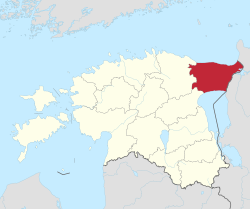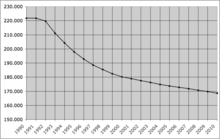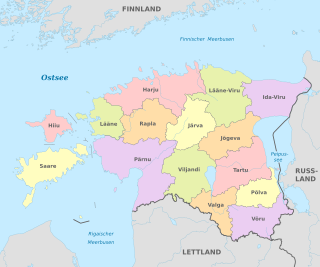
Counties are the state administrative subdivisions of Estonia. Estonian territory is composed of 15 counties, including 13 on the mainland and 2 on islands. County governments were abolished at the end of 2017, with their duties split between state authorities and local governments, and nowadays counties have no noteworthy independent competences. Counties are composed of municipalities of two types: urban municipalities and rural municipalities, which are by law required to cooperate in development of their county.

Harju County, is one of the fifteen counties of Estonia. It is situated in Northern Estonia, on the southern coast of the Gulf of Finland, and borders Lääne-Viru County to the east, Järva County to the southeast, Rapla County to the south, and Lääne County to the southwest. The capital and largest city of Estonia, Tallinn, is situated in Harju County. Harju County is the largest county in Estonia in terms of population, as almost half (45%) of the Estonia's population lives in Harju County.

Järva County is one of 15 counties of Estonia. It is situated in the central part of the country and borders Lääne-Viru County to the east, Jõgeva County to the south-east, Viljandi County to the south, Pärnu County to the south-west, Rapla County to the west, and Harju County to the north. In January 2009, Järva County had a population of 29,940 – constituting 2.7% of the total population in Estonia.

Rapla County is one of the fifteen counties of Estonia. It is situated in the western part of the country and borders Järva County to the east, Pärnu County to the south, Lääne County to the west, and Harju County to the north. In 2022 Rapla County had a population of 33,529 – constituting 2.5% of the total population of Estonia.

Lääne-Viru County is one of 15 counties of Estonia. It is in northern Estonia, on the south coast of the Gulf of Finland. In Estonian, lääne means western and ida means east or eastern. Lääne-Viru borders Ida-Viru County to the east, Jõgeva County to the south, and Järva and Harju counties to the west. In January 2013, Lääne-Viru County had a population of 58,806: 4.5% of the population in Estonia.

Kohtla-Järve is a city and municipality in northeastern Estonia, founded in 1924 and incorporated as a town in 1946. The city is highly industrial, and is both a processor of oil shales and is a large producer of various petrochemical products. During the 1944–1991 Soviet occupation, large numbers of immigrant workers from Russia and other parts of the former USSR were brought in to populate the rapidly growing city. The population in the Kohtla-Järve area which had been, as of 1934 census, over 90% ethnic Estonian, became overwhelmingly non-Estonian in the second half of the 20th century. According to more recent data 21% of the city's population are ethnic Estonians; most of the rest are Russians. Kohtla-Järve is the fifth-largest city in Estonia in terms of population.

Jõhvi is a town in northeastern Estonia, and the administrative centre of the Ida-Viru County and Jõhvi Parish. The town is situated about 50 km west of the Estonia–Russia international border.
The coats of arms of the 15 counties of Estonia are presented below.

Ida-Virumaa FC Alliance is an Estonian football club operating in Ida-Viru County. They play in the Esiliiga, the second highest level of Estonian football league pyramid. The club was created in 2012, when Kohtla-Järve JK Alko and Kohtla-Järve FC Lootus joined together. Before 2021, the team was called Kohtla-Järve JK Järve.
Viru Keemia Grupp (VKG) is an Estonian holding group of oil shale industry, power generation, and public utility companies.

Toila Parish is an Estonian municipality located in Ida-Viru County. It has a population of 4,735 (2019) and an area of 266 km².
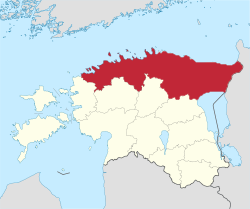
Northern Estonia is a geographical region of Estonia, consisting of the three northernmost counties - Harju County, Ida-Viru County and Lääne-Viru County. The largest towns of Northern Estonia are Tallinn, Narva, Kohtla-Järve and Rakvere. Northern Estonia is the most populous area in Estonia, with 60.3% of the population living there.
Pajualuse is a village in Jõhvi Parish, Ida-Viru County in northeastern Estonia. It is located about 4 km (2 mi) southwest of the town of Jõhvi and 2 km west of Ahtme, district of Kohtla-Järve, by the Jõhvi–Tartu–Valga road (E264). The entrance of the Viru oil shale mine is located to the south, in Kalina. As of the 2011 census, Pajualuse's population was 50.
Tammiku may refer to several places in Estonia:
Pauliku is a village in Jõhvi Parish, Ida-Viru County in northeastern Estonia. It is located just southwest of the town of Jõhvi and northwest of Ahtme, district of Kohtla-Järve. Pauliku is bordered by the Tallinn–Narva railway to the north and Tammiku spoil tip to the south. As of the 2011 census, the settlement's population was 70.
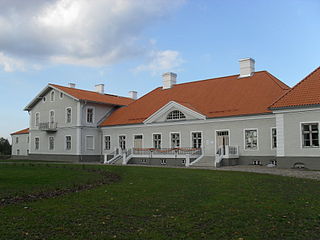
Kukruse is a village in Toila Parish, Ida-Viru County in northeastern Estonia. It is located by the Tallinn–Narva road (E20), between the cities of Kohtla-Järve and Jõhvi. Adjacent to the village is a district of Kohtla-Järve sharing the same name, Kukruse.
Tallinn-Narva maantee is a 212-kilometre-long west-east national main road in Estonia. The road is part of the European route E20. The road forms a major transport west-south transport route between Russia and Europe. The highway starts in Tallinn and passes a number of major Estonian cities and towns, namely Rakvere, Kohtla-Järve, Jõhvi and Sillamäe. The highway ends in Narva on Friendship Bridge, with a border crossing to Russia over the Narva river.
Põhimaantee 3 is a 220-kilometre-long north-south national main road in Estonia. The route follows the same path as the European route E264. The highway starts in Jõhvi. From there the main cities passed are Ahtme and Tartu. The highway ends in Valga on the intersection with the T6.

Jaan Kalviste was an Estonian chemist, mineralogist, educator, and translator.

